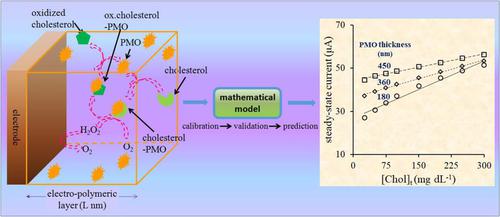当前位置:
X-MOL 学术
›
Electroanalysis
›
论文详情
Our official English website, www.x-mol.net, welcomes your
feedback! (Note: you will need to create a separate account there.)
Mathematical Modelling of a Non‐enzymatic Amperometric Electrochemical Biosensor for Cholesterol
Electroanalysis ( IF 2.7 ) Pub Date : 2020-02-03 , DOI: 10.1002/elan.201900354 Arpit Goyal 1 , Pallab Kumar Bairagi 1 , Nishith Verma 1, 2
Electroanalysis ( IF 2.7 ) Pub Date : 2020-02-03 , DOI: 10.1002/elan.201900354 Arpit Goyal 1 , Pallab Kumar Bairagi 1 , Nishith Verma 1, 2
Affiliation

|
Thickness of the electro‐polymerized layer grown on a substrate and used as the recognition element for the analyte is critical to measuring the response of a biosensor, with high sensitivity and accuracy. However, it is difficult to control the thickness during synthesis. A mathematical model is developed in this study that considers thickness of the electro‐polymerized layer in simulating the electrochemical response of a non‐enzymatic biosensor for cholesterol in blood. The model includes transient kinetics and one‐dimensional diffusion of the analyte in the poly‐methyl orange (PMO) recognition layer electrochemically grown on the electrode. The governing partial differential equations resulting from the species conservation balances in the PMO layer are numerically solved. Time and spatial concentration profiles of the analyte in the PMO layer are determined. Model predictions are calibrated with the experimental data for different PMO thicknesses. Interestingly, model predictions show a linear response over the calibrated concentration range of cholesterol for all PMO layer thicknesses. Based on the chronoamperometry measurements, the model predictions for the cholesterol concentrations measured in the laboratory samples were also found to be remarkably accurate. This is the first mathematical model developed to understand the transport and kinetics of an analyte in the electro‐polymerized layer used as the recognition element of a non‐enzymatic biosensor.
中文翻译:

非酶类胆固醇电化学生物传感器的数学建模
在基材上生长并用作分析物识别元素的电聚合层的厚度对于以高灵敏度和准确性测量生物传感器的响应至关重要。然而,在合成期间难以控制厚度。在本研究中,开发了一个数学模型,该模型在模拟非酶生物传感器对血液中胆固醇的电化学响应时考虑了电聚合层的厚度。该模型包括在电极上电化学生长的聚甲基橙(PMO)识别层中的分析物的瞬态动力学和一维扩散。从数值上求解了由PMO层中的物种守恒平衡引起的控制偏微分方程。确定了PMO层中分析物的时间和空间浓度分布。使用不同PMO厚度的实验数据对模型预测进行校准。有趣的是,模型预测表明,在所有PMO层厚度下,胆固醇的校准浓度范围内都存在线性响应。基于计时电流法测量,还发现实验室样品中测得的胆固醇浓度的模型预测非常准确。这是第一个开发的数学模型,用于了解电聚合层中用作非酶生物传感器识别元素的分析物的迁移和动力学。模型预测表明,对于所有PMO层厚度,在校准的胆固醇浓度范围内线性响应。基于计时电流法测量,还发现实验室样品中测得的胆固醇浓度的模型预测非常准确。这是第一个开发的数学模型,用于了解电聚合层中用作非酶生物传感器识别元素的分析物的迁移和动力学。模型预测表明,对于所有PMO层厚度,在校准的胆固醇浓度范围内线性响应。基于计时电流法测量,还发现实验室样品中测得的胆固醇浓度的模型预测非常准确。这是第一个开发的数学模型,用于了解电聚合层中用作非酶生物传感器识别元素的分析物的迁移和动力学。
更新日期:2020-02-03
中文翻译:

非酶类胆固醇电化学生物传感器的数学建模
在基材上生长并用作分析物识别元素的电聚合层的厚度对于以高灵敏度和准确性测量生物传感器的响应至关重要。然而,在合成期间难以控制厚度。在本研究中,开发了一个数学模型,该模型在模拟非酶生物传感器对血液中胆固醇的电化学响应时考虑了电聚合层的厚度。该模型包括在电极上电化学生长的聚甲基橙(PMO)识别层中的分析物的瞬态动力学和一维扩散。从数值上求解了由PMO层中的物种守恒平衡引起的控制偏微分方程。确定了PMO层中分析物的时间和空间浓度分布。使用不同PMO厚度的实验数据对模型预测进行校准。有趣的是,模型预测表明,在所有PMO层厚度下,胆固醇的校准浓度范围内都存在线性响应。基于计时电流法测量,还发现实验室样品中测得的胆固醇浓度的模型预测非常准确。这是第一个开发的数学模型,用于了解电聚合层中用作非酶生物传感器识别元素的分析物的迁移和动力学。模型预测表明,对于所有PMO层厚度,在校准的胆固醇浓度范围内线性响应。基于计时电流法测量,还发现实验室样品中测得的胆固醇浓度的模型预测非常准确。这是第一个开发的数学模型,用于了解电聚合层中用作非酶生物传感器识别元素的分析物的迁移和动力学。模型预测表明,对于所有PMO层厚度,在校准的胆固醇浓度范围内线性响应。基于计时电流法测量,还发现实验室样品中测得的胆固醇浓度的模型预测非常准确。这是第一个开发的数学模型,用于了解电聚合层中用作非酶生物传感器识别元素的分析物的迁移和动力学。











































 京公网安备 11010802027423号
京公网安备 11010802027423号